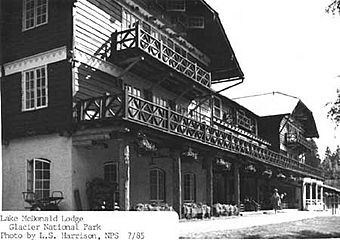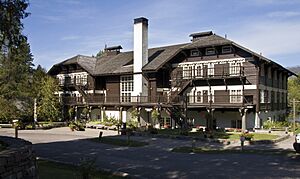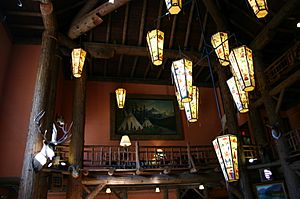Lake McDonald Lodge facts for kids
|
Lake McDonald Lodge
|
|
|
U.S. Historic district
Contributing property |
|

The lake elevation of Lake McDonald Lodge
|
|
| Location | West Glacier, Montana |
|---|---|
| Area | 2.25 acres (0.91 ha) |
| Built | 1913 |
| Architect | Cutter & Malmgram |
| Part of | Lake McDonald Lodge Historic District (ID78000280) |
| MPS | Glacier National Park MRA (AD) |
| NRHP reference No. | 87001447 |
Quick facts for kids Significant dates |
|
| Added to NRHP | May 28, 1987 |
| Designated NHL | May 28, 1987 |
| Designated CP | May 22, 1978 |
The Lake McDonald Lodge is a special historic building. It is found inside Glacier National Park in Montana. The lodge sits right on the southeast shore of Lake McDonald.
This lodge is a 3+1⁄2-story building. It was built in 1913. The design came from an architect named Kirtland Cutter. The bottom part and first floor walls are made of strong stone. The rest of the building is made of wood. The main lobby is a very big, open room. It goes all the way up to the third floor! There is a huge fireplace in the lobby. The floor looks like flagstones, and it has messages written in different Native American languages.
The Lake McDonald Lodge is famous for its "Swiss chalet" style. This means it looks like a large, fancy mountain house you might see in Switzerland. Because of its unique design, it was named a National Historic Landmark in 1987. This means it's a very important historical place in the United States. The lodge is also part of Historic Hotels of America. This group includes hotels that have kept their history and special character.
Contents
History of Lake McDonald Lodge
The Lake McDonald Lodge was first called the Lewis Glacier Hotel. It was actually the second hotel built in this spot. The very first hotel, called the Snyder Hotel, was built in 1895. To get there, people would ride a steamboat for about 10 miles. Before that, they took a horse-drawn carriage and a ferry boat!
Building the Lewis Glacier Hotel
John Lewis, a land buyer from Columbia Falls, Montana, built the Lewis Glacier Hotel. He bought the land in 1904-1905. He wanted to build a grand hotel. This was happening at a time when the Great Northern Railway was also building many hotels and cabins in the park. Some of these included Many Glacier Hotel and Glacier Park Lodge.
Railroad companies wanted to bring more tourists to beautiful places. They built fancy resorts to match the amazing scenery. John Lewis also wanted his hotel to be impressive. The Spokane company of Kirtland, Cutter and Malmbren designed his hotel. It was a much bigger project than the first hotel. They worked through the winter of 1913-1914 to build it. The hotel opened in June 1914. Its design continued the "Swiss cottage" look that the Great Northern railway hotels already used.
A famous artist named Charles M. Russell often stayed at the hotel in the 1920s. People say he etched pictures into the original fireplace in the dining room.
Changes Over Time
In 1930, the Great Northern Railway bought the hotel. They owned it through their company, the Glacier Park Hotel Company. The hotel's name was changed to Lake McDonald Lodge in 1957.
A big flood in 1964 damaged the lodge. It destroyed the fireplace and the etchings by Charles M. Russell. The hotel was sold to the Dial Corporation in 1981. Later, it became part of the Viad company.
The lodge was greatly fixed up in 1988-1989. Workers restored many details that had been hidden or damaged by the flood. Today, the lodge still looks much like it did in the past. Besides the main lodge, there are also small cottages and a motor inn nearby for guests. The main lodge was officially named a National Historic Landmark in 1987.
What Lake McDonald Lodge Looks Like
The Lake McDonald Lodge faces the lake. In the early days, visitors arrived by boat from the lake side. Later, the Going-to-the-Sun Road was built. This meant visitors started arriving at what used to be the back of the hotel. Even though it gets a lot of traffic now, this entrance still feels like a side door. Road access came to the lodge by 1921.
The main building is 3+1⁄2 stories tall. It has a stone foundation and a wood frame above. Most of the outside stone is now covered with white stucco. The upper floors have brown wood siding. They also have fancy white wooden patterns on the upper levels. The large white stucco chimney stands out at the main entrance.
Inside the Lodge
The hotel has a very large lobby. It is near the northeast end of the building. The lobby faces southeast. In the middle of one wall is a big stone fireplace. It sits in a cozy, recessed area called an inglenook. A large window is above the fireplace.
The lobby is three stories high. It is decorated with animal skins and stuffed animals that are native to the area. John Lewis, the builder, used to trap animals to help his hotel business. There are balconies on the second floor on both sides of the lobby. More balconies are on the second and third floors at the back. The heavy wooden beams that hold up the building are visible in the lobby. The stairways to the upper floors have natural, bumpy log pieces.
Guest rooms are mostly on the two upper floors. The dining room is to the southwest of the lobby on the main floor. It is a 1+1⁄2-story wing that faces the lake. A kitchen wing is right next to it. Outside, there are balconies on all sides where the guest rooms are. There are also porches on the ground levels. The outside wood framing uses both cut timbers and logs, sometimes with the bark still on them. Some of the log railings on the balconies have been replaced with decorative wooden railings. However, log railings are still in the upper parts of the lobby.
Original Furnishings and Art
Many of the original furniture pieces are still at the lodge. Several hickory chairs with log frames are original. The piano and a large table are also original, along with many animal trophies. Other furniture pieces are copies of old styles. The rugs are copies of designs by Gustav Stickley.
The hanging lanterns in the lobby are special. They are copies of original lanterns made by Kanai craftspeople. These lanterns were first made for the Prince of Wales Hotel in Waterton Lakes National Park, Canada. They were moved to Lake McDonald in the 1960s. In 2013, the lodge got a large painting. It is a 4x8 foot mural showing Lake McDonald. Artist Ace Powell painted it right there in 1962. A couple from Cincinnati, Ohio, who were visiting Glacier Park, asked him to paint it.
The Lake McDonald Hotel was named a National Historic Landmark on May 28, 1987. It is also part of a larger area called the Lake McDonald Lodge Historic District. This district was added to the National Register of Historic Places on May 22, 1978.
Images for kids
See also
 In Spanish: Lake McDonald Lodge para niños
In Spanish: Lake McDonald Lodge para niños






